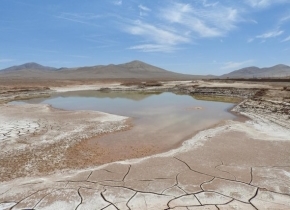

在2015年和2017年,反常的风暴抹去了阿塔卡马沙漠里许多适应干燥的微生物,这对地球外生命搜寻工作来说是个有用的信息。
撰文\播音:克里斯托弗•因塔利亚塔(Christopher Intagliata)
翻译:陈美娟
校对:张艺箫
The Atacama desert in Chile is one of the driest spots on Earth. Sometimes, you can't see any life at all.
智利的阿塔卡马沙漠是世界上最干燥的地方之一。在那里,有时你完全看不到任何生命的踪迹。
"As I was a kid those drives were very boring…because there was nothing to see."
“我还是个孩子的时候,这段路途是那么无趣……因为实在没什么好看的。”
Armando Azua-Bustos was born and raised in Atacama. He’s now an astrobiologist at the Spanish National Research Council's (CSIC) Center for Astrobiology.
阿曼多•阿祖-乌巴斯图斯(Armando Azua-Bustos)在阿塔卡马地区出生、长大。他现在是西班牙国家研究委员会天体生物学中心的一名天体生物学家。
But he says, with closer inspection, life can be found. "There is life around, but you have to take a microscope to see microorganisms in those driest places in the Atacama."
但他说,随着进一步观察,现在能够找到生命的踪迹了。“这周边有生命存在,但你需要在阿塔卡马干燥的区域用显微镜来观察微生物有机体。”
Then in 2015, and again in 2017, freak storms from the Pacific flooded the Atacama. Ten times the usual amount of rain fell, turning some of the driest parts of the desert into lagoons.
在2015年和2017年,从太平洋刮来的反常风暴淹没了阿塔卡马地区。往常10倍量的降水,把这片沙漠最干燥的一些区域变成了小片淡水湖。
But the desert's hardy microbial life didn't exactly burst into bloom. "I start looking at the microscope and I couldn't see anything! That was surprising. I was expecting to see a zoo of little things moving all around. But I couldn't see anything."
然而在沙漠里有顽强生命力的微生物的数量并没有爆发式增长。“我一直盯着显微镜但我什么也没有发现!这太对出乎我的意料了。我原本还期待能看到一大堆小生命动来动去呢。但我什么也没看到。”
In fact, after sampling three of the newly submerged areas, his team found only a quarter of the microscopic species they'd previously isolated in the desert region—perhaps, he says, because the water killed the rest, through a process called "osmotic shock." "The cell doesn't have the mechanisms to get all the water that is going into the cell to get it out, so they start inflating like a small balloon until they burst out."
事实上,在对三个新增的淹没区域进行取样时,他的团队发现,被他们从沙漠地区隔离到显微镜下的物种中,仅存四分之一。他说,有可能是因为水通过一个叫做“渗透休克”的过程把剩下的那些生命杀死了。“它们的细胞没有那种让全部进入细胞的水全部出来的机制,所以它们像小气球一样不断膨胀,直到炸裂。”
The results are in the journal Scientific Reports. [A. Azua-Bustos et al., Unprecedented rains decimate surface microbial communities in the hyperarid core of the Atacama Desert]
这项研究结果刊登在《科学报告》期刊上。
The microbial massacre should serve as a cautionary tale, he says, as we search for similar dry-adapted lifeforms on Mars. Because several of the life-detecting experiments performed by the Viking landers involved—you guessed it—adding water. And it would be tragic if we killed the first extraterrestrial life we found.
他说,当我们在火星上搜寻类似的适应干旱的生命形态时,要把这场微生物大屠杀看做是一个前车之鉴。因为你知道的,一些维京号火星车参与的生命保护实验中有加水这个步骤。要是我们把我们首次发现的外星生命杀死的话,那将是个悲剧。
 京公网安备11010502039775号
京公网安备11010502039775号